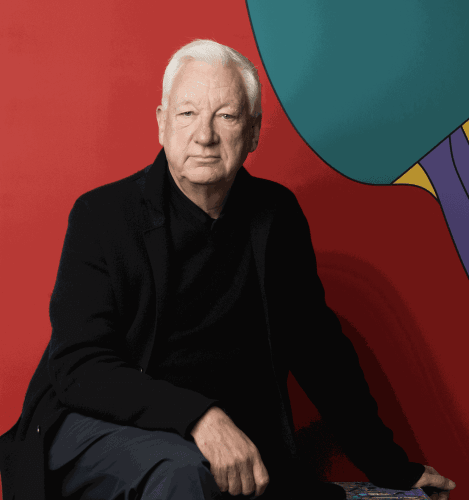Michael Craig-Martin was born in Dublin Ireland in 1941. He grew up and was educated in the United States, studying Fine Art at the Yale School of Art and Architecture. He has lived and worked in Britain since 1966.
His first solo exhibition was at the Rowan Gallery, London, in 1969. He participated in the definitive exhibition of British conceptual art, The New Art at the Hayward Gallery in 1972. His best known works include An oak tree of 1973, in which he claimed to have changed a glass of water into an oak tree; his large-scale black and white wall drawings; and his intensely coloured paintings, installations, and commissions, including the European Investment Bank in Luxembourg, the Laban Dance Centre in London (in collaboration with Herzog and deMeuron), the DLR station at Woolwich Arsenal, and, most recently, the HDI Gerling Headquarters in Hannover.
Michael Craig-Martin has been immersed in a world of industrially manufactured objects since the 1970s. Since then, he has continuously enlarged and updated this universe of objects, using them to explore the aesthetics of contemporary consumer society everywhere. In retrospect, one can say that Craig-Martin's œuvre up to today serves as a documentary archive, recording not only our shift from the analogue to the digital world, but also the constant acceleration in production and everyday consumption, as well as the never-ending growth of the sheer range of products that are made.
In essence, Craig-Martin is known for his brightly coloured, starkly reduced depictions of industrially produced objects found in everyday life. These include our irreplaceable day-to- day electronic companions such as Airpods, iPhones, and MacBooks, but also design classics such as high back trainers or the Barcelona chair. All of these and more have been immortalised by the ‘father of the Young British Artists’ using his acrylic paints in the alternative colour spectrum, and always reduced to their most elementary lines. By radically breaking these objects down to their foundational essences, Craig-Martin turns them into icons – and thus gives objects back the visibility they have lost, having become invisible to us thanks to their ubiquity and accessibility.
In his recent works he also depicts cut flowers and vegetable collages. However, although these objects initially seem very incongruous – nature versus technology – they all faithfully follow the principle of Michael Craig-Martin's work, as they represent objects from today’s Western consumer society that have become so commonplace in our everyday lives that we hardly even notice them. Yet tomatoes and avocados, like sunflowers or MacBooks, are also domesticated and mass-produced, and thus they too represent the fact that organic goods can be manufactured just like artificial goods. These new motifs are a logical extension of Craig-Martin's pictorial vocabulary.
Craig-Martin is well known to have been an influential teacher at Goldsmiths College, London. He was a Tate Trustee from 1989 to 1999, was awarded a CBE in 2000 and was elected an RA in 2006. In 2016 he was knighted in the Queen’s Birthday Honours for his services to art.
His works can be found in numerous international collections such as the Tate Modern Gallery in London, the Irish Museum of Modern Art in Dublin, the Centre Georges Pompidou in Paris, the Museum of Modern Art in New York, and the Australian National Gallery in Canberra. In 2015, he also had his first major solo show in Asia titled ‘NOW’. It was shown as a touring exhibition in the Himalayas Museum in Shanghai and in the Hubei Museum of Art in Wuhan.
Michael Craig-Martin lives and works in London.
